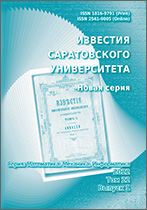|
Scientific Part
Mechanics
Passive damping of vibrations of a cylindrical shell interacting with a flowing fluid
S. V. Lekomtsev, V. P. Matveenko, A. N. Senin
Institute of Continuous Media Mechanics of the Ural Branch of the Russian Academy of Sciences, 1 Academician Korolev St., Perm 614013, Russia
Abstract:
The possibility of passive damping of vibrations of a thin-walled cylindrical shell interacting with a flowing fluid is evaluated. The mechanism is based on connecting the open piezoelectric ring fixed on the surface of the structure to an external shunt electric circuit consisting of series-connected resistance and inductance coil. Their optimal values were selected numerically using the developed finite-element algorithm. The proposed approach is based on solving a series of modal problems. It allows us to obtain higher damping ratios compared to those evaluated by the commonly used analytical expressions and leads to the smallest difference in the natural frequencies of the structure and the electric circuit. In modeling a spatial shell, its curvilinear surface is approximated by a set of flat segments. Each of them is supposed to comply with the relations of the theory of multilayer plates and the equations of linear theory of piezoelasticity written for the case of plane stress state. With this approach, in the vectors of electric field and electric induction it is possible to keep nonzero only such components that are normal to the electroded surface of the piezoelectric ring. The constitutive relations, describing the vortex-free dynamics of an ideal compressible fluid in the case of small perturbations, are formulated in terms of the perturbation velocity potential. The corresponding wave equation is written in the coordinate system associated with the structure and is transformed together with the impermeability condition and boundary conditions to a weak form using the Bubnov – Galerkin method. The paper analyzes the variation of the complex eigenvalues of an electromechanical system depending on the values of resistance and inductance of a series electric circuit. Different methods for calculating the optimal parameters of the system are compared. The frequency response curves demonstrating a decrease in the amplitude of forced harmonic vibrations at a given fluid flow velocity are obtained.
Key words:
passive vibrations damping, piezoelectric ring, electric circuit, cylindrical shell, flowing fluid, finite element method.
Received: 26.04.2022
Accepted: 18.11.2022
Citation:
S. V. Lekomtsev, V. P. Matveenko, A. N. Senin, “Passive damping of vibrations of a cylindrical shell interacting with a flowing fluid”, Izv. Saratov Univ. Math. Mech. Inform., 23:2 (2023), 207–226
Linking options:
https://www.mathnet.ru/eng/isu979 https://www.mathnet.ru/eng/isu/v23/i2/p207
|

|




 Contact us:
Contact us: Terms of Use
Terms of Use
 Registration to the website
Registration to the website Logotypes
Logotypes








 Citation in format
Citation in format 